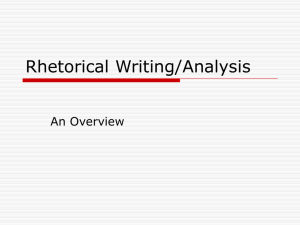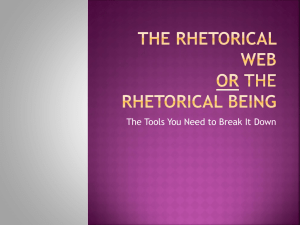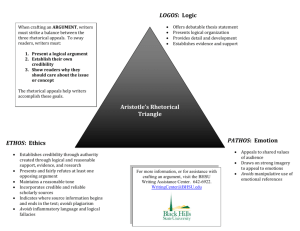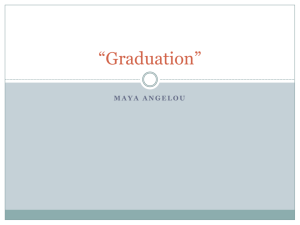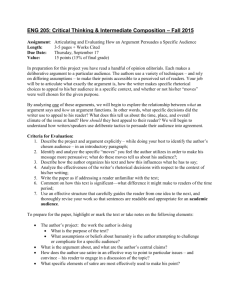How To Succeed With the Rhetorical Analysis AP Essay Rhetoric is
advertisement
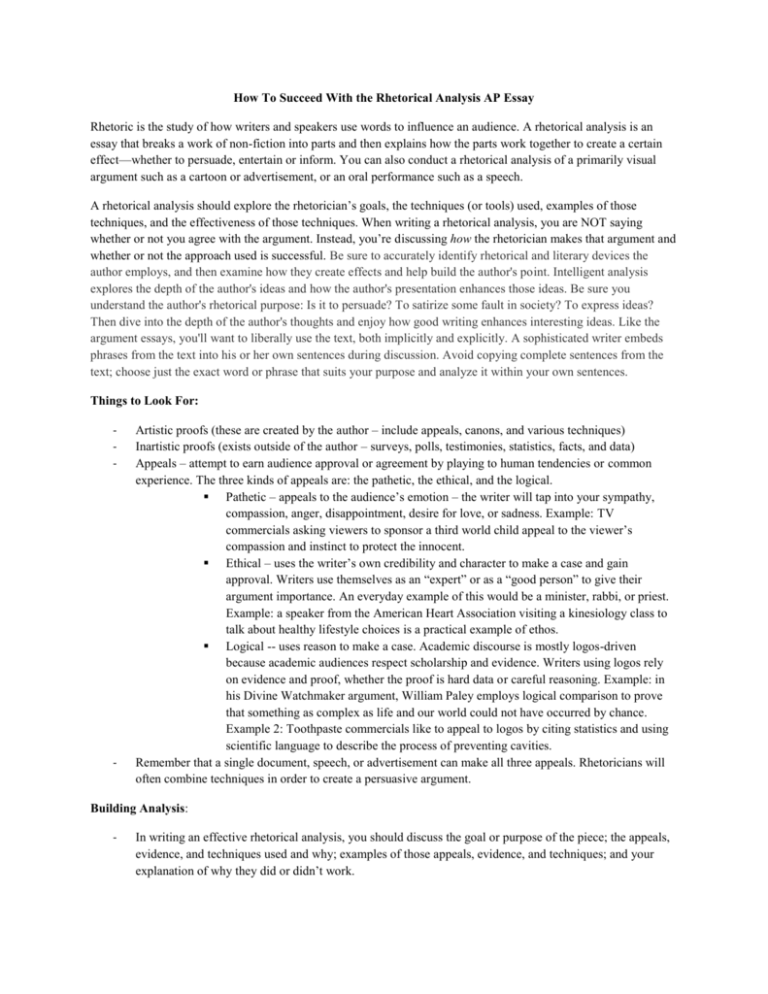
How To Succeed With the Rhetorical Analysis AP Essay Rhetoric is the study of how writers and speakers use words to influence an audience. A rhetorical analysis is an essay that breaks a work of non-fiction into parts and then explains how the parts work together to create a certain effect—whether to persuade, entertain or inform. You can also conduct a rhetorical analysis of a primarily visual argument such as a cartoon or advertisement, or an oral performance such as a speech. A rhetorical analysis should explore the rhetorician’s goals, the techniques (or tools) used, examples of those techniques, and the effectiveness of those techniques. When writing a rhetorical analysis, you are NOT saying whether or not you agree with the argument. Instead, you’re discussing how the rhetorician makes that argument and whether or not the approach used is successful. Be sure to accurately identify rhetorical and literary devices the author employs, and then examine how they create effects and help build the author's point. Intelligent analysis explores the depth of the author's ideas and how the author's presentation enhances those ideas. Be sure you understand the author's rhetorical purpose: Is it to persuade? To satirize some fault in society? To express ideas? Then dive into the depth of the author's thoughts and enjoy how good writing enhances interesting ideas. Like the argument essays, you'll want to liberally use the text, both implicitly and explicitly. A sophisticated writer embeds phrases from the text into his or her own sentences during discussion. Avoid copying complete sentences from the text; choose just the exact word or phrase that suits your purpose and analyze it within your own sentences. Things to Look For: - - Artistic proofs (these are created by the author – include appeals, canons, and various techniques) Inartistic proofs (exists outside of the author – surveys, polls, testimonies, statistics, facts, and data) Appeals – attempt to earn audience approval or agreement by playing to human tendencies or common experience. The three kinds of appeals are: the pathetic, the ethical, and the logical. Pathetic – appeals to the audience’s emotion – the writer will tap into your sympathy, compassion, anger, disappointment, desire for love, or sadness. Example: TV commercials asking viewers to sponsor a third world child appeal to the viewer’s compassion and instinct to protect the innocent. Ethical – uses the writer’s own credibility and character to make a case and gain approval. Writers use themselves as an “expert” or as a “good person” to give their argument importance. An everyday example of this would be a minister, rabbi, or priest. Example: a speaker from the American Heart Association visiting a kinesiology class to talk about healthy lifestyle choices is a practical example of ethos. Logical -- uses reason to make a case. Academic discourse is mostly logos-driven because academic audiences respect scholarship and evidence. Writers using logos rely on evidence and proof, whether the proof is hard data or careful reasoning. Example: in his Divine Watchmaker argument, William Paley employs logical comparison to prove that something as complex as life and our world could not have occurred by chance. Example 2: Toothpaste commercials like to appeal to logos by citing statistics and using scientific language to describe the process of preventing cavities. Remember that a single document, speech, or advertisement can make all three appeals. Rhetoricians will often combine techniques in order to create a persuasive argument. Building Analysis: - In writing an effective rhetorical analysis, you should discuss the goal or purpose of the piece; the appeals, evidence, and techniques used and why; examples of those appeals, evidence, and techniques; and your explanation of why they did or didn’t work. o o - - Ex. The goal – to get readers to see the ridiculousness of Americans’ obsession with physical appearance and our weird ideas about “hygiene.” Ex. Rhetorical techniques used and why – didactic tone makes the author sounds like a high scholar to give credibility and create a sense of superiority for himself and the reader. Uses detached, academic diction to put distance between the reader and the “tribe” being studied. Uses common ground to place himself and the reader on the level of superior, civilized beings studying this tribe, only to turn it when the reader realizes the “tribe” is America. Uses amplification to describe and display the idiocy of practices like teeth whitening. Does all of this to appeal to logic and readers’ sense of pride and superiority (pathetic appeal). Uses irony by including a quote from another author at the end that pokes fun at us for our feeling superior. After brainstorming and doing the actual analysis, you are ready to write a thesis. Remember to choose the three (or four) techniques for which you can make the strongest case. Rhetoricians employ many techniques; focus on the ones that are the most prevalent or interesting and that you can describe persuasively. Ex. Thesis: In his article “Body Rituals Among the Nacirema,” Miner effectively convinces his reader of the ridiculous nature of America’s obsession with the body’s health and visual appeal by allowing his readers to form a third party opinion of themselves before realizing they are their own subject. Miner achieves this by employing an academic tone, detached diction, and superior common ground to place his reader on the level of a scholar observing a native “tribe.” Questions to Consider How does the speaker/writer create and communicate meaning? How does the speaker/writer accomplish purpose? How does the speaker/author establish tone? What/How does the speaker/author use literary devices and rhetorical strategies? How does the text’s organization/structure/arrangement of ideas influence its meaning or effectiveness? What To Do (In A Nutshell): Strong Thesis that focuses the essay on HOW the author uses language to create meaning. Strong Topic Sentences that focus each body paragraph. Analysis and Elaboration (thoroughly explain your reasoning) Provide Examples from by referring to the text and through use of partial quotes. Don’t do too much. Do a few things (2 or 3) well. Consider the following: Rhetorical Triangle (Speaker/Writer, Topic/Subject, Audience) Appeal (Emotional, Logical, and Ethical/Authority) and Context Diction (the author uses diction to …) Tone (the author establishes a particular type of tone) Syntax (repetition, parallel structure, questions, etc.) Use of Language Literal (descriptive, selection of detail, etc.) Figurative (imagery, symbolism, metaphor, simile, personification, etc.)
